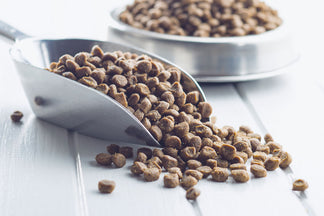When evaluating a pet food, the macronutrient profiles – protein, fat, and carbohydrates -- are three of the most important factors in determining the suitability of the food for your pet. Still, there are other things to look for on the pet food label if you want to choose the best food possible (for your budget). One of those key ingredient groups are fruits and vegetables.
No Dessert Until You Finish your Veggies
For years, humans have been encouraged to eat plentiful amounts of fruits and vegetables each day. The reason? Fruits and vegetables are loaded with anti-oxidants and other beneficial components including vitamins, phytonutrients, and fiber. They may help us fight off disease, improve organ health, maintain a healthy weight, and lengthen our lives. The same may be true for pets.
Dogs are descendants of the carnivore wolf and thus are meat eaters by nature. Their ancestral diet most likely consisted of meat and fish with a small amount of fruits and vegetables that were found in the stomachs of their prey or that were easily accessible when meat sources were limited. Their longstanding relationship with humans has helped them evolve to a more omnivorous lifestyle and thus, their bodies are able to process nutrients from fruits and vegetables.
Cats are obligate carnivores and meat eaters. Like dogs, cats would also consume their fruits and vegetables mostly from the stomachs of their prey.
Yet, for both species, with a few exceptions (e.g., grapes, raisins and onions), fruits and vegetables can provide similar health benefits as they do for humans.
Why Include Fruits and Vegetables in Pet Food?
Although fruits and vegetables are mostly tertiary ingredients in commercially available pet food, they can provide some key benefits including:
- They are a relatively low calorie source of fiber and vitamins.
- They are a relatively low calorie and natural way to add sweetness to the food.
- They contain antioxidants that can reduce inflammation and possibly reduce the risk of some cancers. Dr Knapp, a veterinary oncologist at Purdue University found that serving dogs vegetables at least three times a week reduced the risk of bladder cancer by 70%.
- They can be an additional source of water (in the canned foods), which can be especially important in the summer months.
- They are a healthy, whole food source of vitamins and minerals.
Bottom Line on Fruits and Vegetables in Pet Food
Fruits and vegetables can offer your pet added nutritional value. They are the preferred source of many vitamins and minerals, especially when compared to the alternative of synthetic or isolated vitamin additives (which may not actually provide any benefit at all and might actually cause harm).
Because vegetables are often tertiary ingredients in most pet foods, you will usually find them listed after the protein and fat sources in the ingredient list. That doesn’t mean you shouldn’t look for them however. Foods rich in fruits and vegetables are naturally tasty, sweet, and antioxidant laden when compared to those without. And they often contain less artificial additives than foods with little or no fruits and vegetables in their recipe.
SmartFeeder can help you find foods with healthy fruits and vegetables as part of their ingredient list. It can also alert you when your food relies too heavily on artificial or synthetic ingredients as a source of vitamins and minerals or as a source of color and sweetness.


 Food
Food
 Food
Food
 Food
Food
